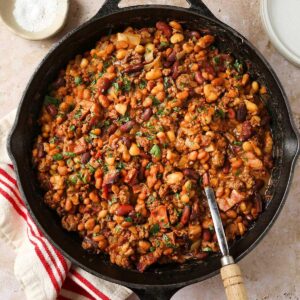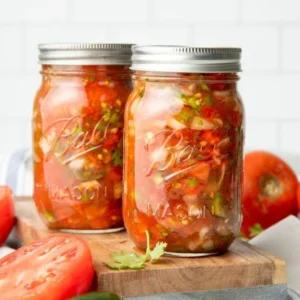Pumpernickel bread is a dense, dark rye bread known for its slightly sweet and earthy flavor. Originating in Germany, this rustic bread has a rich cultural history and is a staple in many European kitchens. Its deep color comes from a mix of whole rye flour and sometimes molasses, giving it a distinct, savory flavor that pairs wonderfully with a wide range of dishes. Whether you’re making it for sandwiches, toasts, or as an accompaniment to soups, pumpernickel offers a unique taste and texture that’s beloved around the world.
Ingredients
To make your own pumpernickel bread, you will need the following ingredients:
-
2 cups whole rye flour
-
1 cup all-purpose flour
-
1/2 cup dark molasses or maple syrup (for a lighter flavor)
-
1 tablespoon caraway seeds (optional but traditional)
-
1 packet active dry yeast (about 2 1/4 teaspoons)
-
1 1/2 cups warm water (110°F)
-
1 tablespoon salt
-
1 tablespoon vegetable oil (or melted butter for extra flavor)
Substitutions:
-
Gluten-Free Option: Substitute with a gluten-free all-purpose flour blend.
-
Dairy-Free Option: Use vegetable oil instead of butter.
-
Vegan Option: Molasses is naturally vegan, so no changes needed here.
Step-by-Step Cooking Instructions



1. Activate the Yeast
-
In a small bowl, combine warm water and the active dry yeast. Let it sit for about 5 minutes until the mixture becomes frothy. This ensures the yeast is alive and active.
2. Mix the Dry Ingredients
-
In a large mixing bowl, combine the whole rye flour, all-purpose flour, salt, and caraway seeds. Mix them well to evenly distribute the salt and caraway.
3. Add Molasses and Yeast Mixture
-
Create a well in the center of the dry ingredients. Pour in the molasses and the yeast mixture. Stir until the dough starts to form. It should be sticky and slightly wet.
4. Knead the Dough
-
Transfer the dough onto a floured surface. Knead the dough for about 8-10 minutes, adding a little extra flour if needed to prevent sticking. The dough should become smooth and elastic.
5. Let the Dough Rise
-
Place the dough in a lightly oiled bowl, cover with a clean kitchen towel, and let it rise in a warm place for 1-2 hours, or until it doubles in size.
6. Shape and Bake the Bread
-
After rising, punch down the dough to release air bubbles. Shape it into a loaf and place it on a greased baking pan. Let it rise again for about 30 minutes.
-
Preheat your oven to 375°F (190°C). Bake the loaf for 35-40 minutes, or until the bread sounds hollow when tapped on the bottom.
7. Cool and Serve
-
Allow the bread to cool on a wire rack before slicing. This helps the texture set and makes it easier to slice.
Common Mistakes to Avoid:
-
Don’t use water that’s too hot when activating the yeast. Water over 120°F can kill the yeast, preventing the dough from rising.
-
Avoid over-kneading the dough, as this can make the bread too dense.
Pro Tips and Cooking Techniques
-
For a richer flavor: Try adding a small amount of cocoa powder or instant coffee to the dough. This intensifies the dark color and adds complexity to the flavor.
-
Caraway seeds are traditional, but if you’re not a fan, you can substitute them with fennel or coriander seeds for a different flavor profile.
-
Resting the dough: Allow the dough to rise twice (first in the bowl, then after shaping) for better texture and flavor development.
Variations and Customizations
-
Gluten-Free: Use a gluten-free all-purpose flour blend and adjust the water as needed for the right dough consistency.
-
Low-Carb: For a low-carb option, substitute the rye flour with almond flour, although this will change the texture.
-
Add-ins: You can mix in other seeds or nuts like sunflower seeds, flax seeds, or walnuts for extra crunch and flavor.
Serving Suggestions
Pumpernickel bread is wonderfully versatile and can be enjoyed in many ways:
-
Serve it with creamy butter and jam for breakfast.
-
Pair it with hearty soups like lentil or split pea.
-
Top it with smoked salmon, cream cheese, and dill for an elegant appetizer.
Nutritional Information (per slice)
-
Calories: 150
-
Protein: 4g
-
Carbs: 30g
-
Fats: 2g
-
Fiber: 5g
Frequently Asked Questions (FAQs)
How do I store pumpernickel bread?
Store your pumpernickel bread in a cool, dry place. It will stay fresh for 3-4 days, but you can freeze it for up to 3 months for longer storage.
Can I use sourdough starter instead of yeast?
Yes, you can substitute sourdough starter for the yeast, though it will require a longer rise time. Be sure to adjust the liquid content as needed.
Closing Thoughts
Pumpernickel bread is not only delicious but also a fun and rewarding baking project. Whether you’re making it for sandwiches or simply enjoying it with a bowl of soup, this bread brings a hearty flavor to any meal. Experiment with different variations and enjoy the unique flavors of homemade pumpernickel. Share your baking success with us, and feel free to ask any questions along the way!



